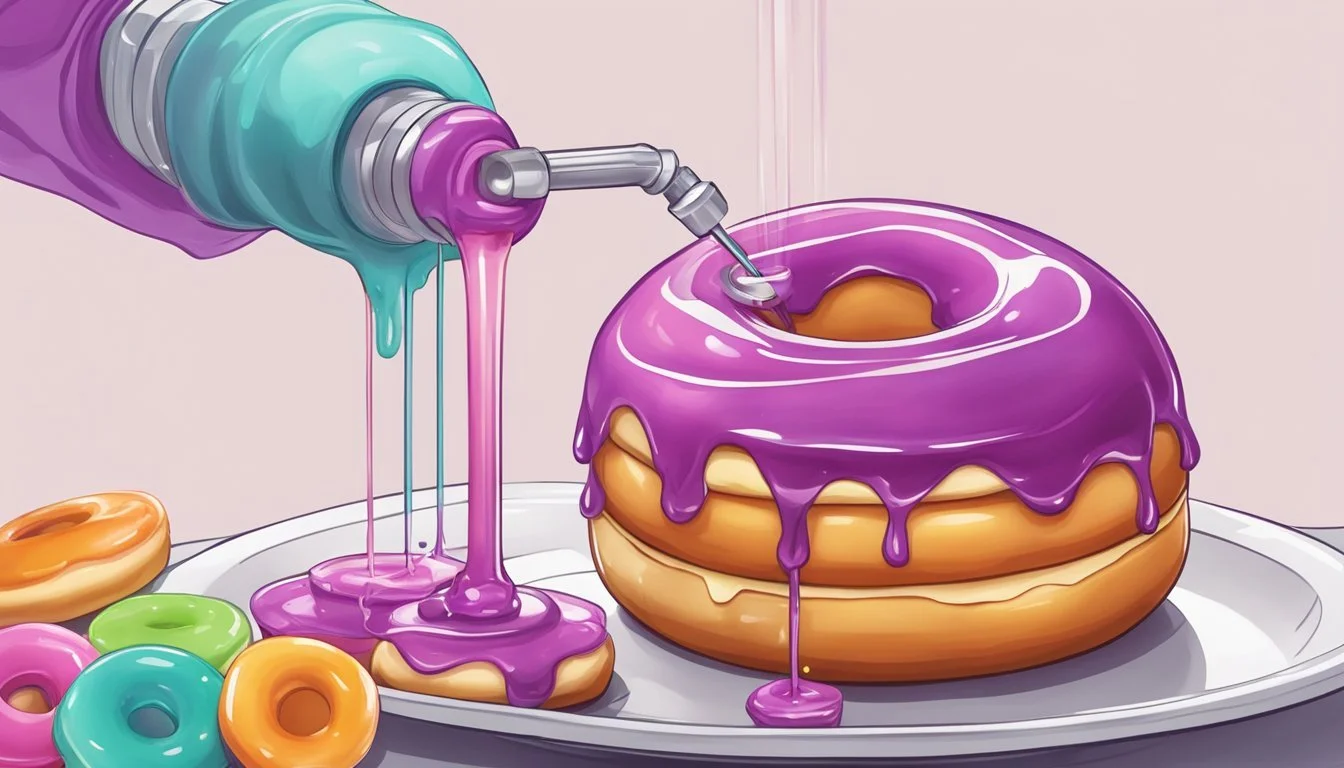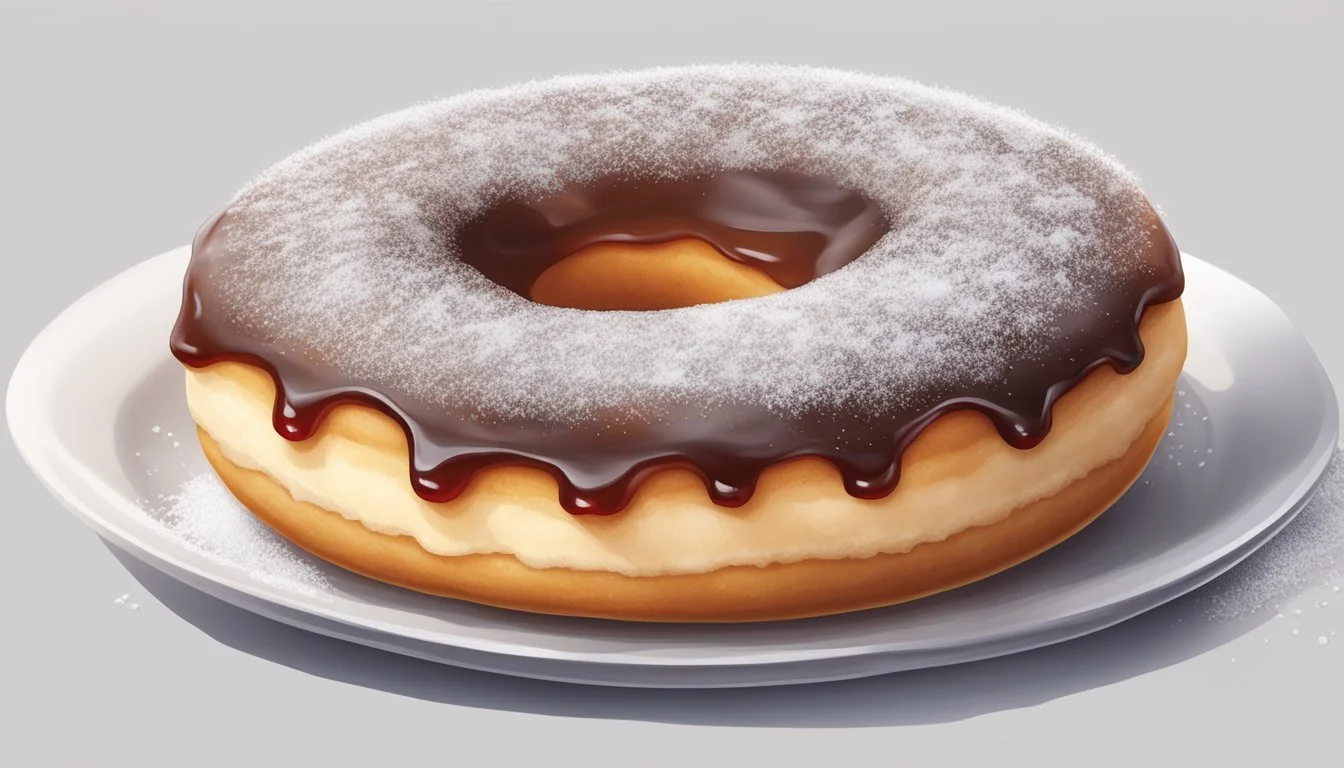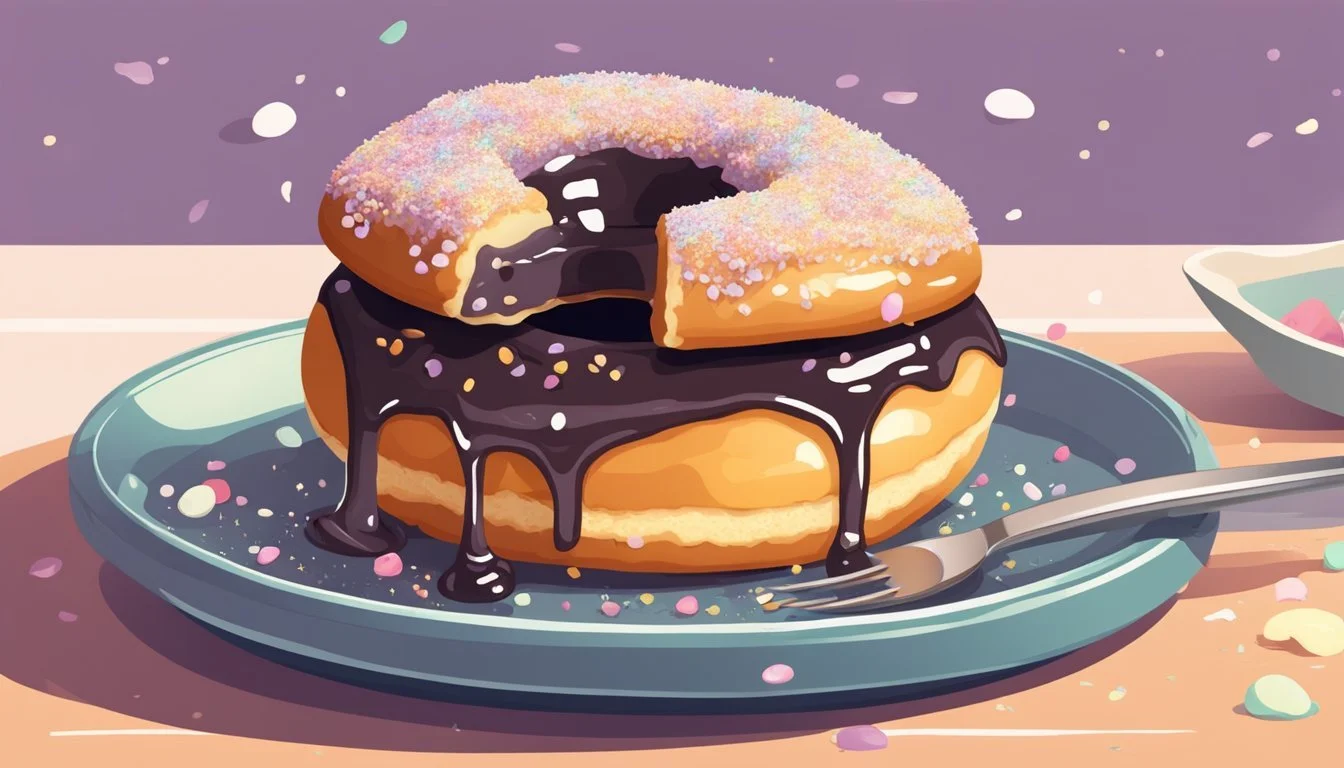How do you eat a jelly donut?
Mastering the Mess-Free Technique
Eating a jelly donut can be a delightful and sweet experience. These delicious treats, filled with various flavors of jelly, are a popular choice for those seeking a fun and indulgent snack. However, due to the sticky and gooey nature of jelly, enjoying a jelly donut without making a mess can be quite the challenge. The key is in the approach and technique, ensuring the sweet treat can be savored with minimal spillage and maximum enjoyment.
To negotiate the potential for mess, one might consider cooling the donut briefly, as this can firm up the jelly and reduce the likelihood of it spilling out with each bite. Another strategy involves biting into the portion of the doughnut with the least amount of filling and making one's way gradually to the jelly center. Moreover, using a napkin or tissue paper to catch any escaping filling can help maintain cleanliness during the indulgence.
It's also important to consider the eating environment. When one is on the go, strategic bites and awareness of the donut's structure are even more crucial. If seated at a table, utensils can come into play, such as a small knife to cut the donut into manageable pieces, or a fork to steady it while taking bites. In this way, one can relish the sugary confection with poise and pleasure.
History and Significance
Jelly donuts (how long do donuts last?), known by various names in different cultures, carry a rich heritage and are often linked with specific festivities and rituals. Their historical popularity during special occasions is a testament to their cultural significance.
Cultural Associations with Jelly Donuts
Jelly donuts, or sufganiyot as they are called in Hebrew, hold a special place within the Hanukkah tradition. Hanukkah, the Jewish festival of lights, is characterized by the consumption of oil-fried foods, commemorating the miracle of the Temple oil that lasted for eight days. Sufganiyot are deep-fried, typically injected with jelly, and dusted with powdered sugar, aligning with the festival's theme of oil-based foods.
In Poland, pączki are the equivalent to jelly donuts and were traditionally enjoyed during the Christmas season, Hanukkah, and other special events. These sweet treats are known to be made with rich dough and are filled with various preserves or custard, showcasing the culinary versatility of jelly donuts.
Typical Occasions for Jelly Donut Consumption
Hanukkah: Sufganiyot are a staple for the Jewish holiday, with millions consumed during the season. Here's an outline of the traditional jelly donut recipe:
Ingredients: Flour, sugar, yeast, eggs, milk, jelly or jam for filling, and oil for frying.
Procedure: The dough is prepared, left to rise, then shaped into balls, fried until golden, filled with jelly, and finally dusted with sugar.
Other Special Occasions: In many cultures, jelly donuts, like latkes, are often featured at various celebrations and family gatherings. They are not only limited to religious holidays but also appear during communal festivities, reflecting their role in social and cultural contexts beyond their origins.
Choosing the Right Ingredients
To create the perfect jelly donut, one needs to carefully select high-quality ingredients for the dough and filling. Precise measurements and the right components make all the difference in the texture and flavor of the final product.
Essential Ingredients for Jelly Donuts
For the dough of jelly donuts, the key ingredients include:
All-purpose flour: This is the base of the dough and provides the structure.
Active dry yeast: Essential for fermentation, it helps the dough to rise.
Granulated sugar: Adds sweetness and helps in browning.
Salt: Enhances the flavors and regulates yeast activity.
Milk: Often warmed, it hydrates the dough, enriching it with flavor and tenderness.
Eggs: Contribute to the richness and color of the dough.
Unsalted butter: Adds moisture and creates a tender crumb.
The balancing act of these ingredients is crucial for a successful dough that is both flavorful and has the right texture, ready to be filled with a delicious center.
Selecting the Best Jelly or Jam
For the filling, the selection of jelly or jam can define the character of your donut. Here are some popular choices:
Strawberry jam: A classic choice known for its balance of sweetness and tartness.
Seedless raspberry jam: Offers a vibrant burst of flavor without the distraction of seeds.
Apricot jam: Provides a subtly sweet and tart complement to the dough.
Lemon curd: Introduces a citrusy zest, adding a refreshing twist.
Cherry jam: Brings in a deep, sweet flavor reminiscent of classic desserts.
Choosing a high-quality jam or jelly is as important as the dough. It should have a consistent texture that's not too runny to prevent spillage while eating and not too firm to ensure a delightful burst of flavor with each bite.
Dough Preparation
Creating the perfect dough for jelly donuts involves a balance of ingredients and techniques to achieve a fluffy and soft texture. The dough's preparation is crucial for the final taste and quality of the donuts.
Mixing the Dough
To initiate the dough preparation, the baker combines the dry ingredients such as flour, sugar, and salt in a large bowl. Yeast is then dissolved in warm milk, activating it, which is a vital step for proper dough rise. The liquid ingredients, including the milk and yeast mixture, eggs, and sometimes honey, are gradually added to the dry mixture. The baker uses a dough hook on a stand mixer to incorporate the ingredients at a low speed initially and then at a medium speed until the dough begins to form. Butter is typically added last, one tablespoon at a time, ensuring it is fully integrated into the dough.
Proofing Process
After mixing, the dough must proof, allowing the yeast to ferment and the dough to rise. This procedure is essential for the development of a light and fluffy texture. The dough is often covered with plastic wrap and left in a warm place to rise until it doubles in size. This process can take approximately an hour but may vary depending on the temperature and humidity levels in the environment.
Shaping and Filling Considerations
Post-proofing, the dough should be turned out onto a floured surface to prevent sticking and to allow for ease of handling. The baker then shapes the dough into small even balls, ensuring there are no air pockets which might affect the cooking process. The dough balls are arranged on baking trays lined with parchment paper, covered lightly with plastic wrap, and left to rise again until they puff up. Correct shaping is crucial, as it affects the donuts' ability to hold the jelly filling properly without bursting or becoming misshapen during frying.
Cooking Techniques
The approach to cooking jelly doughnuts can influence their texture and taste. Proper heat application and timing are crucial whether one opts for frying or baking.
Frying the Doughnuts
To fry jelly doughnuts, one typically requires a deep fryer or a heavy-bottomed pot, such as a Dutch oven, filled with at least 2 inches of oil. The oil of choice is often neutral, with canola or vegetable oil being popular picks due to their high smoke points. One heats the oil to a precise temperature of 350°F to 360°F, monitored by a thermometer. Doughnuts are then carefully placed in the oil using a slotted spoon or spider utensil to avoid splashing. Frying should be done for one to two minutes per side until golden brown.
Baking Alternatives
Baking serves as a healthier option compared to frying. To bake jelly doughnuts, one should preheat the oven or an air fryer - a more contemporary baking device - maintaining a temperature around 320°F to 350°F. The doughnuts are placed on a baking sheet lined with parchment paper to prevent sticking, and then cooked until they turn a light golden color. Air frying is a quick process that can give results similar to traditional baking but in a shorter time frame.
Filling the Doughnuts
To fill doughnuts effectively, it is essential to select the right tool and technique for inserting the filling without damaging the doughnut's structure.
Choosing the Correct Filling Method
When filling homemade jelly doughnuts, one should select the appropriate texture and consistency of the fill. The fill could be jelly, jam, cream, or custard. The key is ensuring the filling is not too rigid; otherwise, it won't pipe smoothly, and not too runny, which could cause a mess. The tool of choice is typically a piping bag or pastry bag equipped with a narrow tip for creams or custards (how long do custards last?) and a wider tip for chunkier jellies or jams.
Jelly Injection Techniques
To begin the filling process, insert the pipette tip gently into the side of the doughnut, making a small incision. Squeeze the bag until the doughnut starts to expand slightly, indicating that the filling has filled the cavity. It's important not to overfill to avoid leaking. For an even distribution in larger doughnuts, one might need to inject filling into different sides. If using a pastry bag, ensure it is fitted with a metal tip wide enough to allow the jelly or jam to pass through without clogging.
Finishing Touches
The final steps in preparation elevate the simple jelly donut to a confectionary delight. The right sugar coating not only adds texture but complements the flavorful filling, while thoughtfully crafted serving suggestions ensure a lasting impression.
Sugar Coating Options
After frying, while the donuts are still warm, the applicable coating should be applied to adhere properly. The primary options include:
Granulated Sugar: Provides a crisp outer layer with a slight crunch.
Powdered Sugar: Offers a delicate sweetness and a classic snow-dusted appearance.
Cinnamon Sugar: A mixture of granulated sugar and cinnamon adds a spicy warmth to the sweet profile.
One may also experiment with flavored sugars, incorporating elements like vanilla extract or citrus zest for a unique twist.
Serving Suggestions
Presentation can enhance the overall enjoyment of jelly donuts. They can be served:
Warm: Heating them slightly (if they have cooled) accentuates the jelly's flavor.
With Complements: Fresh berries such as raspberry or blueberry can be offered alongside.
Chocolate Drizzle: A bit of melted chocolate drizzled over the top integrates rich, indulgent notes.
Accompanying Beverages: Coffee, tea, or milk pairs well, balancing the donut's sweetness.
Practical Tips and Tricks
Eating a jelly donut can be messy, but with the right approach, one can enjoy it with minimal spillage. Maintaining the optimal oil temperature during cooking and ensuring proper storage afterward are crucial for the best donut experience.
Oil Temperature and Cooking Time
When frying jelly donuts, it's imperative to keep the oil temperature consistently at 350°F. A thermometer is a useful tool to monitor this. Cooking time should be carefully managed; typically, it's 2-3 minutes per side until golden brown. Here's a quick guide:
Preheat oil to 350°F.
Fry donuts for 4-5 minutes, flipping them every 30-60 seconds.
Adjust heat as necessary to maintain the temperature.
Proper Handling and Storage
Once the donuts are cooked, they should be handled gently to avoid squeezing out the jelly. Use paper towels to absorb excess oil. For storage, donuts are best kept at room temperature in an airtight container. To preserve freshness:
Allow to cool on a wire rack.
Store in an airtight container for up to two days.
To keep longer, freeze them and reheat as desired.
The refrigerator can alter the texture of the donut, so it is recommended to avoid refrigerating unless absolutely necessary.
Recipe Variations
When exploring jelly donut recipes, one can consider two major aspects: the source of the donuts—homemade versus store-bought—and the type of fillings and dough used. These variations affect not only the flavor and texture but also the overall tasting experience.
Homemade versus Store-bought
In terms of homemade jelly donuts, the cook has full control over ingredients and can tweak the recipe to their preference, whether it's making the dough ahead of time or opting for healthier substitutions. Making jelly donuts at home allows for fresh, warm, and potentially more flavorful treats, though it requires more time and effort. On the other hand, store-bought donuts from a trusted donut shop ensure consistency and save time, but they may lack the personalized touch and freshness.
Make Ahead:
Dough: Can be prepared and refrigerated overnight, allowing flavors to meld and reducing preparation time on the day of frying.
Fillings: Can also be pre-made and stored to streamline the donut assembly process.
Different Types of Fillings and Dough
Recipes for jelly donuts may vary widely in terms of fillings and dough.
Fillings:
Traditional fillings include raspberry, strawberry, and other fruit jams or jellies.
Non-traditional fillings such as lemon curd, chocolate, or custard cater to varying preferences.
Dough Types:
Yeast Doughnuts: The classic dough that results in a puffed-up, light, and airy texture.
Cake Doughnuts: A denser dough that is quicker to make due to the absence of yeast.
Each dough type and filling brings its own unique texture and taste to the jelly donut experience. Whether one opts for the classic puffed-up, yeast-risen dough with fruit jam, or a denser cake donut filled with a creamy custard, the joy of making or selecting a jelly donut lies in the multitude of recipe variations available.
Nutritional Information
When considering the nutritional aspects of consuming a jelly donut, it's important to look closely at its caloric content, as well as potential healthier alternatives that might satisfy the same craving.
Caloric Content
A standard jelly donut contains approximately 220-340 calories. The breakdown of these calories typically skews towards fats and carbohydrates. For example, a particular jelly donut might have the following nutritional profile:
Total Fat: Around 10-20 grams, with a mix of saturated and monounsaturated fats
Carbohydrates: Approximately 33-36 grams, with a portion of these coming from sugars
Protein: Around 4-7 grams, a smaller fraction of the overall caloric content
These characteristics are common in commercially available jelly donuts but can vary depending on the size and specific recipe used.
Healthier Alternatives
Consumers seeking to indulge in a jelly donut while mitigating caloric intake may consider the following alternatives:
Baked jelly donuts: Often lower in calories due to reduced fat content
Mini jelly donuts: Smaller portions provide a controlled serving size, reducing overall calorie consumption
Homemade options: Can be tailored to use lower-calorie ingredients or sweeteners
Choosing an alternative with reduced sugar content or a smaller size can help align a jelly donut treat with health-conscious dietary goals.
Frequently Asked Questions
In this section, readers will find answers to queries surrounding the preparation and consumption of jelly donuts. From managing common concerns to tackling more complex donut-making questions, the aim is to provide clear and accurate information.
Common Jelly Donut Concerns
Q: How does one eat a jelly donut without making a mess?
A: To eat a jelly donut neatly, one might let it cool down so the jelly sets slightly firmer. This approach allows for a bit more control. Alternatively, taking smaller bites from the top can help manage the flow of the jelly.
Q: What is the best way to fill a jelly donut without the filling spilling out?
A: To fill a jelly donut properly, use a piping bag with a small, round tip, and carefully inject the jelly through a small incision in the side of the donut. It's best done when the donuts are warm but not too hot, to keep the jelly in place.
Advanced Donut Making Queries
Q: What is the correct way to prepare the yeast mixture for jelly donuts?
A: Mix instant yeast with warm water and a small amount of sugar in a large bowl, allowing it to sit until the mixture becomes frothy. This indicates that the yeast is active.
Q: How does one create the dough for jelly donuts?
A: To create the dough, combine all-purpose flour, kosher salt, and sugar in a large bowl. Incorporate softened unsalted butter or margarine and the active yeast mixture. Knead until the dough is smooth and then allow to proof.
Q: What is the proper technique to fry jelly donuts?
A: After shaping the donuts and allowing them to rise again, heat oil to 350°F (175°C). Fry the donuts until golden and crispy. Let them cool on a wire rack before filling.
Q: How should the dough be handled after the first rise?
A: Once the dough has doubled in size, punch it down gently to release any air bubbles. Shape the donuts immediately after for the second rise, ensuring uniformity for even frying.









